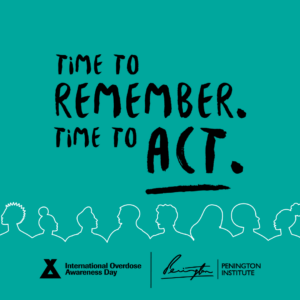International Overdose Awareness Day has been recognized since 2001 to raise awareness of the impact of overdose, remember those who have died, and acknowledge the grief of those who have lost their loved ones to overdose. In the United States, we have lost more than 110,000 friends, family members, and neighbors to overdose—just over the last year. Governors have historically observed this day to remember the lives of those lost, challenge stigma, highlight resources, and acknowledge the impact of overdose on communities throughout their states.

The theme for this year’s International Overdose Awareness Day is “recognizing those people who go unseen.” For the more than 100,000 people who fatally overdosed over the past year, there are several hundred thousand parents, children, partners, friends, communities, and others deeply grieving. There are health care and support services workers who are coping with these losses daily while continuing to serve their communities. There are also first responders, professional as well as laypersons, carrying the emotional burden and cumulative trauma from responding to one or many overdose emergencies. While impacting certain communities more than others, these losses and impacts reach every corner of our society in one way or another.
This International Overdose Awareness Day is an opportunity to acknowledge these unseen individuals whose lives have been impacted by overdose, whether as family, friends, service providers, or those delivering medical aid in overdose emergencies. With the grief of constant loss and the communal trauma of the COVID-19 pandemic, the public health workforce is experiencing unprecedented burnout. Public health workers deserve America’s gratitude as they strive every day to find solutions, prevent deaths, and improve lives. This workforce includes a large proportion of dedicated people with lived experience who may experience burnout even more acutely for a number of reasons. We recognize these impacts and the tireless work of those in Peer Support roles, frontline harm reduction and outreach teams, and healthcare settings that serve people at risk for overdose.
The continuing epidemic of lives lost to overdoses and other drug-related causes often feels overwhelming and defeating. However, those working in this field carry on and save lives every day, by implementing prevention initiatives, distributing harm reduction tools, improving access to high quality Substance Use Disorder treatment, and strengthening community recovery supports. This year the first-ever nonprescription Overdose Reversal Agents (i.e., naloxone) were approved. Amid the increasing threat of xylazine and other adulterants in the drug supply, xylazine test strips were validated for drug checking use and became commercially available this year. Fentanyl test strips as an overdose prevention tool are now legal in most states, with many states taking actions to decriminalize them during this past year. Last year on International Overdose Awareness Day, HHS announced $79.1 million in overdose prevention grants to be awarded.
On this International Overdose Awareness Day, it’s important to recognize the efforts, progress, and personal impacts of the ongoing epidemic for employees of state, territory, and local health and human service agencies, many of whom were drawn to this work because of their own lived experience. Your work is making a difference, even while progress seems incremental, especially in the wake of COVID-19 challenges. The CDC’s National Vital Statistics System (NVSS) reports fewer overdose deaths in 26 states from March 2022 to March 2023 (predicted data); six of the states observing decreases were among the ten states with the highest overdose rates in 2021. Seven states saw decreases of 10% or more. While these decreases feel small amid historically high numbers of lives lost, they represent real people who are still here. They also represent many more families and friends who can still be with their loved ones, regardless of the challenges they may continue to face daily related to Substance Use Disorder or mental illness.
Substance Use Disorder and mental health remain among Governors’ top health priorities, and many Governors have declared historic investments in behavioral health during the past year, including Montana, North Carolina, Wisconsin, Virginia, just to name a few. The NGA Roadmap for Governors, Implementing Best Practices Across the Continuum of Care to Prevent Overdose, released in August, highlights additional states implementing innovative overdose prevention strategies. It also offers 17 evidence-based strategies and best practices Governors can enact across the continuum of prevention, harm reduction, treatment, and recovery. NGA is available for technical assistance to states and territories and remains committed to supporting Governors and their staff in developing policy and program solutions that prevent overdose and save lives.
For more information, please contact Dana Heilman (DHeilman@nga.org).












